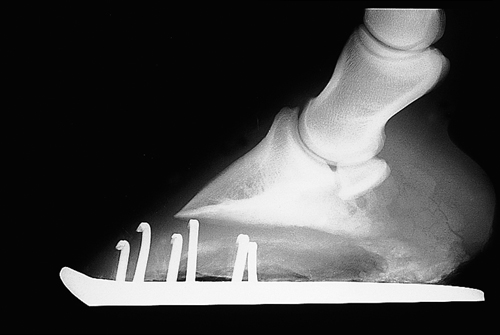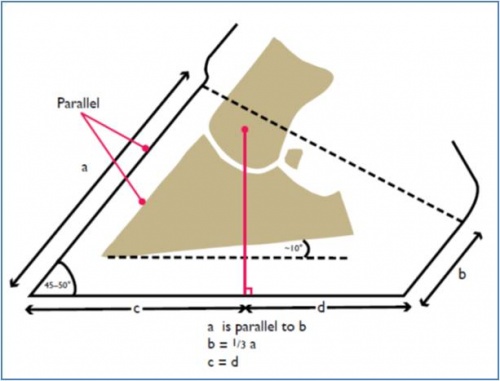Difference between revisions of "Equine Orthopaedics and Rheumatology Q&A 02"
Ggaitskell (talk | contribs) (Created page with "{{Template:Manson May}} centre|500px<br>centre|500px <br />...") |
|||
| (2 intermediate revisions by one other user not shown) | |||
| Line 16: | Line 16: | ||
*A perpendicular line from the centre of a circle drawn around the distal interphalangeal (DIP) joint intersects the weight-bearing surface of the foot close to the heels. The ideal foot conformation is shown in the diagram. | *A perpendicular line from the centre of a circle drawn around the distal interphalangeal (DIP) joint intersects the weight-bearing surface of the foot close to the heels. The ideal foot conformation is shown in the diagram. | ||
*This defective foot conformation is thought to exert abnormal pressure on the palmar soft tissue structures of the foot, leading to pain and possibly eventually navicular disease. | *This defective foot conformation is thought to exert abnormal pressure on the palmar soft tissue structures of the foot, leading to pain and possibly eventually navicular disease. | ||
| − | |l1= | + | |l1=Equine Foot Balance |
|q2=Discuss how this can be improved, and suggest what shoes should be applied. | |q2=Discuss how this can be improved, and suggest what shoes should be applied. | ||
|a2= | |a2= | ||
| Line 25: | Line 25: | ||
*The shoes should not be nailed on past the lateral and medial limits of the foot, and the shoe should extend at least 3–4 mm outside the limits of the wall to allow heel expansion. <br><br> | *The shoes should not be nailed on past the lateral and medial limits of the foot, and the shoe should extend at least 3–4 mm outside the limits of the wall to allow heel expansion. <br><br> | ||
Careful attention should also be paid to the medio-lateral balance of the foot. This will depend on the presence of limb valgus or varus but, in a straight limb, the medial and lateral walls should be of the same height with the medial wall slightly more vertical than the lateral. | Careful attention should also be paid to the medio-lateral balance of the foot. This will depend on the presence of limb valgus or varus but, in a straight limb, the medial and lateral walls should be of the same height with the medial wall slightly more vertical than the lateral. | ||
| − | |l2= | + | |l2=Equine Foot Balance |
</FlashCard> | </FlashCard> | ||
{{#tag:imagemap|Image:Next Question.png{{!}}center{{!}}200px | {{#tag:imagemap|Image:Next Question.png{{!}}center{{!}}200px | ||
| − | rect 0 0 860 850 [[Equine Orthopaedics and Rheumatology Q&A | + | rect 0 0 860 850 [[Equine Orthopaedics and Rheumatology Q&A 03|Next question]] |
desc none}} | desc none}} | ||
[[Category:Equine Orthopaedics and Rheumatology Q&A]] | [[Category:Equine Orthopaedics and Rheumatology Q&A]] | ||
Latest revision as of 15:59, 4 August 2011
| This question was provided by Manson Publishing as part of the OVAL Project. See more Equine Orthopaedic and Rheumatological questions |
A four-year-old Thoroughbred presented with mild chronic bilateral forelimb lameness which responded to palmar digital perineural analgesia.
| Question | Answer | Article | |
| Comment on the foot balance and why this may be significant. | The radiograph shows a severely broken back foot–pastern axis, associated with long toe–low heel conformation.
|
Link to Article | |
| Discuss how this can be improved, and suggest what shoes should be applied. | The foot conformation can be improved by trimming the toe. ‘Dubbing’ the toe will shorten it in a dorsopalmar direction and reduce leverage. If it is possible to shorten the toe in a proximodistal direction, this will improve the angulation of the third phalanx.
Careful attention should also be paid to the medio-lateral balance of the foot. This will depend on the presence of limb valgus or varus but, in a straight limb, the medial and lateral walls should be of the same height with the medial wall slightly more vertical than the lateral. |
Link to Article | |

